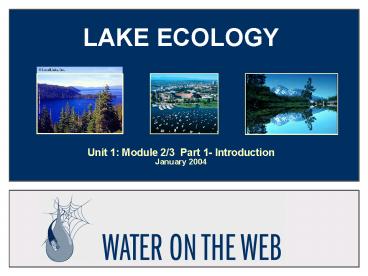LAKE ECOLOGY - PowerPoint PPT Presentation
Title:
LAKE ECOLOGY
Description:
LAKE ECOLOGY Unit 1: Module 2/3 Part 1- Introduction January 2004 Modules 2/3 overview Goal Provide a practical introduction to limnology Time required Two ... – PowerPoint PPT presentation
Number of Views:96
Avg rating:3.0/5.0
Title: LAKE ECOLOGY
1
LAKE ECOLOGY
- Unit 1 Module 2/3 Part 1- IntroductionJanuary
2004
2
Modules 2/3 overview
- Goal Provide a practical introduction to
limnology - Time required Two weeks of lecture (6 lectures)
and 2 laboratories - Extensions Additional material could be used to
expand to 3 weeks. We realize that there are far
more slides than can possibly be used in two
weeks and some topics are covered in more depth
than others. Teachers are expected to view them
all and use what best suits their purposes.
3
Modules 2/3 outline
- Introduction
- Major groups of organisms metabolism
- Basins and morphometry
- Spatial and temporal variability basic physical
and chemical patchiness (habitats) - Major ions and nutrients
- Management eutrophication and water quality
4
1. Introduction - Major Themes
- Lakes reflect their watersheds (soils,
vegetation, landuses) and climates - Morphometry (shape, depth, size) and hydrology
(flushing rate) are important determinants of how
lakes function - Lakes are very patchy - they are not homogeneous
well-stirred bathtubs as they often appear to be
- they exhibit great variability which creates
large and small habitats
5
3 main factors determine a lakes trophic
state(its biological productivity)Watershed,
climate morphometry
- Rate of nutrient supply (from watershed
airshed) - Bedrock geology, soils, vegetation, land uses,
atmospheric deposition - Climate
- Sunlight, temperature, precipitation and
hydrology - Morphometry
- Depth (mean and max),
- size (volume/area),
- roundness (shoreline convolutions)
6
Watersheds extensively covered in Module 1 and
will be further discussed in Modules 4/5
EVERYONE lives in a watershed!
Watershed - the area of land draining to a
particular lake, wetland or stream Everything
that happens on the land affects its water quality
The City of Duluth is made up of many watersheds,
all connected together like the pieces of a puzzle
7
Climate
Climate rain, snow, wind, air temperature,
flows, seasonality play a role in determining a
lakes trophic state.
8
Watershed Lake Surface Area Ratio
How big is the watershed compared to the size of
the lake?
Ratio Watershed Area AwAo Lake Area
Higher ratio higher productivity often poorer
water quality
9
Nutrient loading and Watershed area
10
Morphometry
11
Morphometric (and watershed) characteristics for
Ice Lake
- Morphometry
- Elevation 390 km(1279 ft MSL)
- Lake area (Ao) 16.6 ha (41 acres)
- Watershed area (Aw) 85.4 ha (211 acres)
- AwAo 51
- Maximum depth (Zmax) 16.1 m
- Lake volume (V) 1.6 x 106 m3
- Shoreline length 1.6 km
- Littoral area 32
- Hydraulic residence time (HRT) 2.6 0.9 yrs
(30 yr record)
12
What is retention time?
How long does it take for the lake to get
flushed?
Retention time lake volume outflow
- Longer retention time
- Lake is flushed less often
- Slower to respond
- Pollutants stay put longer
13
Turnover and flushing
- Tt V / Q
- V volume
- Q inflow
- T50 ?
- T1 ?
14
Retention times
- Turnover times for the Laurentian Great Lakes
(approximate retention times) - Lake Superior 191 years
- Lake Michigan 99 years
- Lake Huron 22 years
- Lake Ontario 6.0 years
- Lake Erie 2.6 years
- Turnover times for some WOW lakes (approximate)
- Grindstone Lake, MN 4 yrs
- Ice Lake, MN 3 years
- Lake Washington, WA 2.3 yrs
- Shagawa Lake, MN 1 yr
- Lake Onondaga, NY 0.25 yrs
15
Conceptual framework for lake water quality
GEOCHEMISTRY LAND USE
WATERSHED INPUT
HYDROLOGY
NATURAL NUTRIENTS
ATMOSPHERIC DEPOSITION
SHORELINE DEVELOPMENT
ANTHROPOGENIC NUTRIENTS
INDUSTRIAL-MUNICIPAL EFFLUENTS
HYPOLIMNETIC WINTER O2 - depletion
LAKE MORPHOMETRY
ALGAL BIOMASS (chlorophyll-a)
WATER CLARITY (secchi depth, turbidity)
(Adapted from Hutchinson 1991)
16
More about lake variability (patchiness)
- physical waves, currents, temp, light,
sediments - chemistry major, minor and micronutrients,
gases, in the water and sediments - biology biomass (structure) growth rates
(function) - spatial features in-lake horizontal vertical
variations - time (daily, seasonal, weather events)
The natural variability of these properties
defines different habitats which are optimal for
different organisms
17
(No Transcript)































